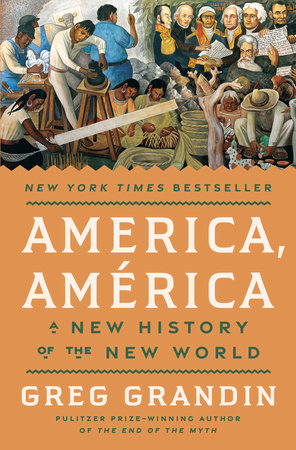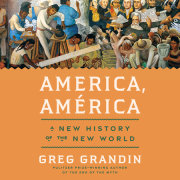1.Leaves of GrassPhilosophy begins in wonder," Socrates said. It matures, Hegel added, in terror, on the "slaughter bench" of history. So it was with the arrival of the Spanish in the New World.
Wonder there was when Christendom realized there existed another half a world, filled with
rarezas, rarities, curious plants and animals but above all people, many more and many more different kinds than lived in all of Europe. Even before Copernicus, Europe was awakening to the idea that the Earth wasn't the center of existence, and that the universe contained, Giordano Bruno would soon reckon, "innumerable suns" and "infinite earths that equally revolve around these suns."
Scholars intuited a link between the celestial and earthly multitudes. There was one heavenly realm, containing an incalculable number of stars. There was one earthly estate, now known to contain many more millions of people than previously imagined. The realization that the earth was not the center of divine creation was as unsettling as the knowledge that Europe wasn't the center of the world.
What did this multiplication mean for the idea of Catholic holism, for the story of Genesis when God at Creation called into being first Adam, then Eve, who together produced a single
linaje, or lineage, of descendants with a shared, if gory, history?
When reconciled with the Catholic premise of celestial unity, the diversity of the New World's peoples could support the ideal of equality. Time spent in the Caribbean, Mexico, and Central America convinced the Dominican priest, Bartolomé de las Casas, that the ancient philosophers and theologians who had argued that there existed categories of inferior humans, people born to be "natural slaves," were wrong. As it turned out, Las Casas wrote, the ancients didn't "know very much" about the world. The Dominican would continue to cite the sages when it suited his purpose, but for him, now, truth was to be found not in Aristotle but in America-and the most important truth was that humans everywhere were fundamentally the same. All were made in God's image. Their differences-skin color, hair texture, cultural practices, and religious beliefs-reflected the vast variety of the infinite divine.
And differences in appearance had nothing to do with human essence, which for Las Casas was everywhere the same. Every Indian he had met in the New World, he said, possessed both free will and the ability to reason. That alone made them human. They could remember the past, imagine the future, estimate probabilities, and could see, hear, feel, smell, and taste. They were born, matured, grew old, and became ill, and when they died their families grieved, as humans did everywhere. When happy, they laughed. When sad, they cried. They took delight in the good and despised the bad. From this, Las Casas issued a famous declaration:
Todo linaje de los hombres es uno-All humanity is one.
At the same time, the New World's conquerors mocked the idea of humanity's oneness, laying the foundation for race supremacy. Spanish settlers and colonists legitimated cruel killing on an unprecedented scale, forcing the New World's inhabitants to labor in mines, fields, and waters, to extract the riches of America-gold, silver, pearls, dyes, and soon sugar and tobacco-that Europe would use to gild its empires, muster its armies, fund its wars, build its cathedrals, and pay for more voyages of conquest and enslavement. Never mind what priests like Las Casas were saying. Theologians were known to say one thing and its opposite. Indians were little better than apes put on earth to serve man. To dominate them was just. To work them to death no more a sin than to butcher a hog.
An Infinity of PeopleThe people of the New World were "found." Then they were lost. Not immediately and not completely, but enough so that a group of Dominican and Franciscan priests wrote their superiors in Spain in 1517 wanting to know where they went. "Where are they, oh most illustrious fathers?" What happened to the men and women who upon Columbus's arrival two decades earlier were so many that they were like "leaves of grass?"
Demographers today aren't sure what the size of America's population was before the arrival of the Spanish. Most estimates fall between fifty and one hundred million inhabitants. The Spanish couldn't say. They knew that the Indies (the name
América was in use for the New World in the early 1500s but not widely adopted until a little later) were densely populated with wildly varied peoples. They ranged from the elysian Taino, who seemed to have lived lush and well-nourished lives on the islands of the Caribbean; to the hierarchically organized, ostentatious, and scientific Aztec and Inka Empires in Mexico and Peru. Columbus thought the island of Hispaniola-Spain's first Caribbean colony, from where Hernando Cortés would soon lead his assault on Mexico-was "paradise," but a populated paradise, completely "cultivated like the countryside around Cordoba." He estimated that the island was home to over a million souls. Las Casas, who, seventeen years old, arrived in the Caribbean on April 15, 1502, thought that number too low. "An infinity of people" lived in the new lands, he later wrote. The New World was "filled with people, like a hive of bees."
"It was," he said, "as if God had placed all, or the majority, of the entire human race in these countries."
Later, European romantics would use the word
sublime to describe the sensation evoked by confrontation with the grandeur and terror of nature, its existential enormity. And there's some of this feeling in the letters and chronicles left by Spanish warriors. As the Conquest proceeded, as Cortés began his march through Mexico, they wrote of their exploits climbing high peaks equal to the Alps, navigating great river systems, and trekking through dense forests. The volcano Popocatépetl rained fire and ice, bursting, Cortés wrote King Charles, with "so much force and noise it seemed as if the whole Sierra was crumbling to the ground."
Yet it wasn't nature that bedazzled the Spaniards as much as the "great city" of Tenochtitlán sitting below the volcano. "As large as Seville," Cortés wrote, and more populated than London, with "many wide and handsome streets," fine noble houses, engineered canals, and a complex hydroponic agricultural system. Further south, it wasn't volcanic eruptions that shivered European souls. It was Mapuche warriors overspread across a vast Andean valley mustered to defend their land. They "shook the world around them," one conquistador wrote, "with sudden dread."
There were so many people.
Then they began to die. The consensus is that the population was cut by between 85 to 95 percent within a century and a half. The Spanish Conquest, driven forward at a relentless pace by the consolidating Kingdom of Castile, inaugurated what the demographers Alexander Koch, Chris Brierley, Mark Maslin, and Simon Lewis call history's "largest human mortality event in proportion to the global population," a drop of upward of 56 million people by 1600. "The greatest genocide in human history," wrote Tzvetan Todorov in the 1980s.
The first wave of death was brought by Conquistador terror.
All the World KnowsBartolomé de las Casas's transformation into a critic of the Conquest didn't happen until after the Conquest had made him rich. As a young boy growing up in Seville-he was born in 1484-Bartolomé had witnessed the glory heaped on Columbus upon his return from his first cross-Atlantic voyage and heard the stories of islands filled with gold, spices, and potential slaves. His merchant father, Pedro, and uncles Francisco and Juan were part of Columbus's crew, and Pedro used the wealth he acquired from sailing to pay for his son's education. Bartolomé became a "good Latinist" and began studying to become a priest. When Las Casas first landed in Hispaniola (today divided by Haiti in the west and the Dominican Republic in the east), his head was already crowned with a friar's tonsure. He worked with his father, who had given up sailing to settle on the island as a merchant. Las Casas continued his religious studies and, in 1507, traveled to Rome for his ordination.
He was gone for two years, returning to the Caribbean in 1509, and in his later writings was circumspect about his own service to the Conquest. He accompanied at least one incursion into Hispaniola's western lands, provisioning troops with supplies but also perhaps lending a hand to put down Indians with sword and harquebus. Christopher Columbus's son, Diego Colón, Hispaniola's governor, granted him an
encomienda, or consignment of Indian laborers, on the north coast of the island in the Cibao Valley.
The term
encomienda refers to a kind of slavery, but
indios encomendados, or commended Indians, weren't considered private property, or chattel. Rather, they were formally something like wards, members of an existing village or community, who, in exchange for labor, were to receive instruction in Christian doctrine from their overlords, their guardian encomenderos. The
encomienda was important, but it was just one of many coerced labor systems. There was out-and-out enslavement, of Native Americans and Africans; there were onerous tribute demands and a labor corvée called the
repartimiento. The "Conquest brought about so many forms of Indian servitude," wrote one historian in the early 1900s, "that it is very difficult to master the nature of them all, and to follow them into all their minute details."
Las Casas's conversion was slow in coming, and can be dated to 1512, when he accompanied Captain Pánfilo de Narváez on an expedition to pacify Cuba. He went as a priest, and was horrified as the campaign turned into, as one historian writes, "an odyssey of pillage and plunder, of death and destruction." Massacre followed massacre, until Narváez's men arrived at the last unconquered village, Caonao. There, the soldiers were greeted at dawn by thousands of kneeling Indians, who bowed their heads as Narváez's mounted men took their place in the plaza. The tension Las Casas sets up, as he later reflected on the day's events, between motion and stillness is stunning. The Indians kneel quietly. The horses tower over them. All is quiet except for the shuffle of hooves, as the mounts shift the weight of their riders and their heavy armor. No provocation on the part of the town's inhabitants interrupts the tense calm. Then, suddenly, a soldier unsheathes his sword and starts slashing at those kneeling below him. The rest of Narváez's men join in, killing men, women, children, the sick and the old. They use lances to disembowel victims.
Narváez himself, Las Casas writes, sat calm amid the chaos "as if he were made of marble."
One villager, his intestines spilling out of his stomach, fell into Las Casas arms. The dichotomy in Las Casas's narration is now birth and death, being and nothingness: Las Casas baptized the man and performed last rites in the same breath. After the slaughter was over and the killers had moved on, Las Casas stayed behind to tend to the injured. He cleaned bandages, cauterized wounds, and tried to find some rational explanation for the carnage. He couldn't. The Spanish assault on Cuba, he said, was "a human disaster without precedent: the land, covered in bodies."
Still, though, he remained silent and accepted a second
encomienda for his service on Narváez's campaign. This one, on the southern coast of Cuba, was made up of inhabitants from the village of Canarreo, which sat on the banks of the Arimao River. Las Casas lived there as a merchant priest, in a large, comfortable house built by his Indians. He said Mass in a small chapel and became wealthy. He couldn't, though, shake off the feeling that he was living in sin, violating the commandment not to steal.
Then, in preparation for a sermon to preach on Pentecostal Sunday in 1514, Las Casas, now thirty years old, came upon this sentence from Ecclesiastes: "To take a fellow-man's livelihood is to kill him, to deprive a worker of his wages is to shed blood." No scales fell from his eyes, no repulsion at witnessing babies being torn apart by dogs awakened his consciousness. Rather he simply reflected quietly on these words from Ecclesiastes and then made a decision to change his life. He abandoned his
encomiendas, gave away his riches, and began a life of mendicant poverty and humanist advocacy.
Shortly after Las Casas's conversion, a smallpox epidemic swept through Hispaniola, killing, within a few months, nearly a quarter of the island's population. Settlers mounted more expeditions to capture more slaves from other Caribbean islands and from villages along Venezuela's coast. Africans were now being brought in to replace disappearing Taino, to pan rivers, dig mines, herd cows, and cut cane. As the population dwindled, Spanish cruelty increased.
"So many massacres, so many burnings, so many bereavements, and, finally, such an ocean of evil," wrote Las Casas. The priest's denunciations of violence against the New World's darker people perfected a polemical style based not on revelation or appeals to authority but the power of personal witness. More than a century before the French philosopher René Descartes would posit the thinking, self-aware man as the essence of the modern ego, Las Casas gave us the seeing man, mindful not only of his own existence but of the agony of others: "
Y yo lo vi"-I saw all this, I saw it with my own eyes.
"All the world knows," Las Casas said.
All the world knew largely because Las Casas had told them. Las Casas's famous account of the Conquest,
Brevisima Relación de la Destrucción de las Indias (
A Brief History of the Destruction of the Indies), written in 1542 and first published in Seville a decade later, with the word
destrucción a play on
instrucción.
Instruction being what Catholics were supposed to be providing the inhabitants of America. The book was quickly translated into English, French, German, Dutch, and Italian and widely distributed, especially throughout Protestant Europe. John Milton's nephew published it as
Tears of the Indians in Cromwellian London, one of at least thirty-seven editions printed in England between the late 1500s and the middle of the 1600s.
Las Casas lived during the middle of one of the most violent periods of human history: a three-century-long crisis that roiled Europe and the Mediterranean world. Famines, pestilence, crusades, and war. Wars that lasted a hundred years, wars between Lutherans and Catholics and between Christians and Muslims, the siege of Constantinople, Mitteleuropa's peasant rebellions, the lowland's revolt against Spain, England's conquest of Ireland. Combined, these upheavals turned "the whole of Europe into a bloodbath." Mass murder of unarmed communities was commonplace. Unbelievers, heretics, and infidels were burned at the stake, and mutilated body parts of the enemy were catapulted into besieged cities.
Still, Las Casas maintained that what the Spanish were doing in the New World was worse.
Las Casas filled page after page with extreme colonial gore. Torture, mutilations, massacres. Spanish conquistadores raped women at will. They broiled captives alive and then fed their corpses to dogs. They chopped off the hands of Indians and then told them to deliver the "letter" (that is, the severed body part) to compatriots hiding in the mountains as a message to surrender or face worse. In Mexico, the Spanish wrapped native priests in straw and then burned them to death. "Boar-hounds" tore children apart. Conquistadores used their swords as spits to roast babies as their mothers watched. They tossed infants into rivers, laughing as they guessed how many times they would bob up for air before drowning.
Copyright © 2025 by Greg Grandin. All rights reserved. No part of this excerpt may be reproduced or reprinted without permission in writing from the publisher.






